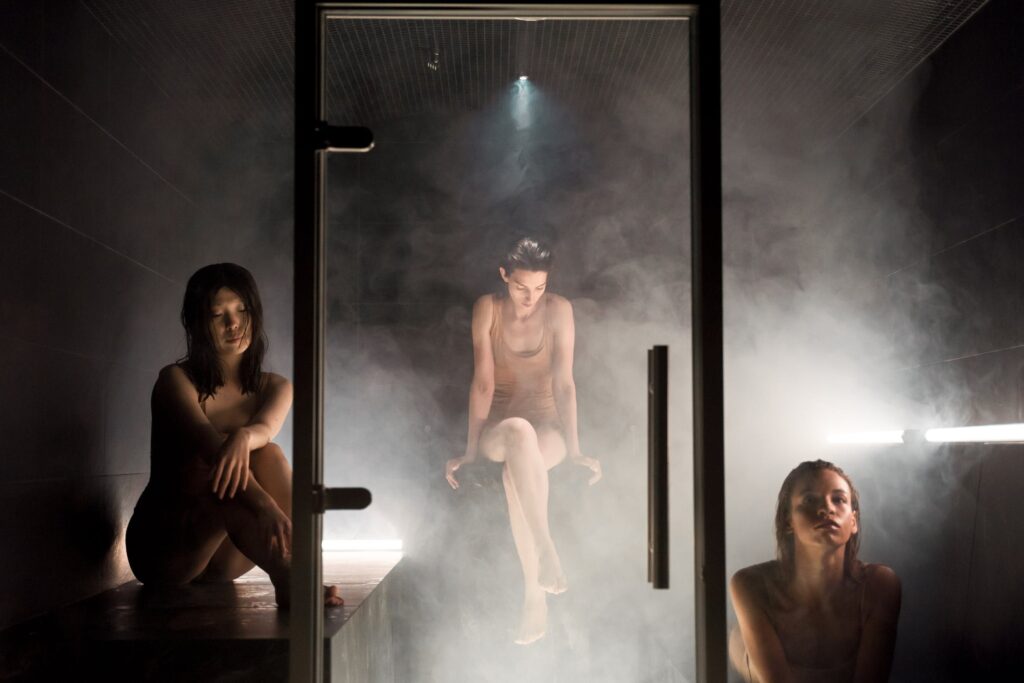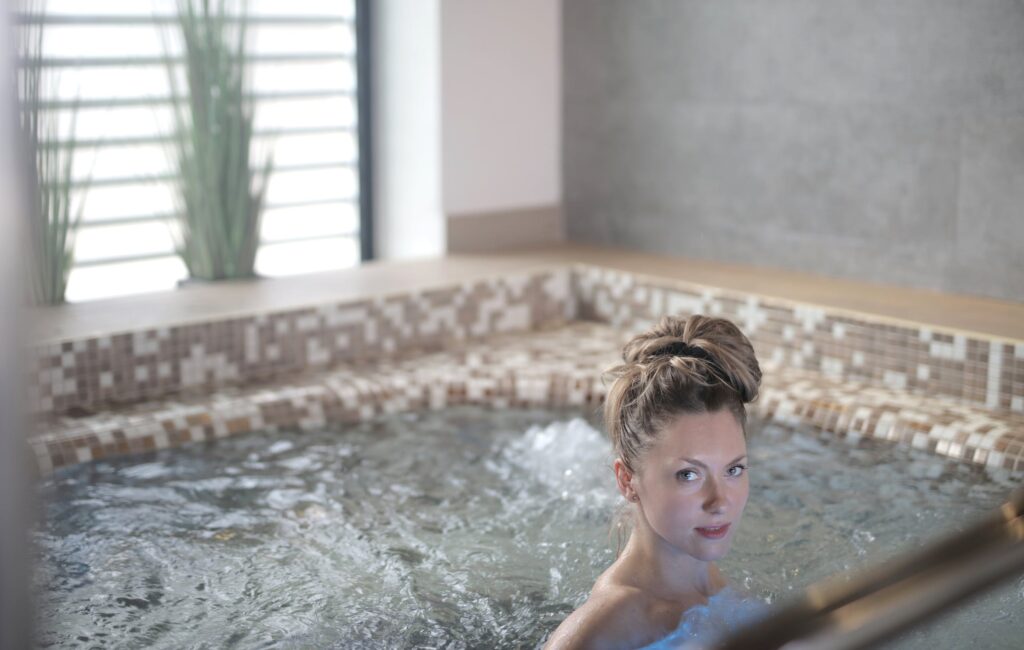Intense physical activity, such as running, cycling, or strength training, is typically thought of as the best way to work up a nice sweat. In spite of this, you still have the option of becoming warm in an infrared sauna, which will also allow you to relax and refresh your body.
People who are looking for a more comfortable approach to warm their bodies often turn to infrared saunas because of their reputation for reducing muscle pain, enhancing the quality of sleep, and contributing to an overall sense of calm. There are certain dangers involved with utilizing an infrared sauna, despite the fact that doing so is generally regarded as being safe for most individuals.
We all enjoy working up a good sweat, be it in a sauna, sweat lodge, or steam room. Aside from the fact that heat has long been connected with a variety of health advantages across a wide variety of cultures, it is also calming and revitalizing.
Infrared saunas are the most recent fad that is contributing to rising temperatures. Not only are there an increasing number of free-standing infrared sauna studios cropping up from coast to coast, but now fitness studios are getting in on the action as well by placing saunas in their facilities. Because infrared heat penetrates deeply into the body, celebrities and health experts are praising it as a superior method for detoxing, relaxing, relieving pain, and losing weight, in addition to being a shortcut to improved skin.
But does all this hype have any basis in reality, or is it all just a lot of hot air? The following is essential information regarding the current trend of using infrared saunas.
Near-infrared saunas and "full-spectrum" saunas, which also use near-infrared technology, have been increasingly popular during the past couple of years. High Tech Health, which has been in the business of manufacturing far infrared saunas for more than two decades, is frequently questioned why it hasn't adopted this "new" technology. There is more than only one company that takes pride in the fact that they have a significantly higher power in the near-infrared range. But should we be using near-infrared technology?
FAQs About Sauna
Contraindications to sauna bathing include unstable angina pectoris, recent myocardial infarction, and severe aortic stenosis. Sauna bathing is safe, however, for most people with coronary heart disease with stable angina pectoris or old myocardial infarction.
Simply sitting in a sauna can enable you to decrease excess fat is not a reality. A sauna does not allow you to lose weight; it temporarily eliminates quickly replaceable water from the body. In addition, excessive heat makes your body sweat and sweating can make you lose fluid in the form of water.
Some commonly known sauna benefit include improved blood circulation, enhanced detoxification processes, deep skin cleansing, and stress relief. Saunas can boost your immune system by raising the body temperature and giving you an “artificial” fever. system is “exercising”, and therefore being strengthened.
Most bacteria thrive at 40°F to 140 degrees°F, and dry saunas range from 176°F to 212°F with less than 20% humidity. This dry, oppressive environment is inhospitable for nearly all bacteria and viruses which thrive under cooler, more moist ecosystems.
Not only does dry heat increase blood flow to your organs and relax your mind and body, but a proper sauna routine can also clear up your complexion.
What is an infrared sauna?
If you enjoy being heated by dry air, there's a strong possibility that you've used a traditional sauna at some point in your life. These saunas heat the air around you and normally run at temperatures ranging from 82.2 to 93.3 degrees Celsius (180 to 200 degrees Fahrenheit).
The North American Sauna Society reports that electric sauna heaters are used in the vast majority of saunas found in both private residences and commercial establishments.
On the other hand, infrared saunas are becoming increasingly popular. Rather than heating the air around you, these saunas employ electromagnetic radiation emitted by infrared lamps to warm the user's body directly.
According to Dr. Fran Cook-Bolden, MD, FAAD, with Advanced Dermatology P.C., "Infrared saunas heat your core temperature and only heat to about 150 degrees Fahrenheit (66 degrees Celsius)"
According to Cook-Bolden, this form of heat is able to permeate deeper into the body, and it is believed to have an effect on and heal deep tissue, in addition to detoxifying the body by sweating through your pores.
An infrared sauna, much like a typical or dry-heat sauna, employs heat to help you sweat, which in turn relieves muscle tightness and allows you to rest, and relax. The distinction lies in the approach that was taken. In traditional saunas, the air is heated to temperatures between 150 and 190 degrees Fahrenheit, whereas in infrared saunas, electromagnetic radiation is used to heat the air.
The heat in a sauna with dry heat can be produced by either electricity or wood, and some people make steam in their saunas by pouring water over rocks that have been heated. Temperatures in traditional saunas can reach between 180 and 190 degrees F, making them exceedingly warm. On the other hand, they do not contain any moisture and have humidity levels that are between 10 and 20 percent.
The body is heated directly by the infrared lamps, which emit electromagnetic radiation, that is utilized in the operation of an infrared sauna. The red, orange and yellow light that is emitted from near-infrared and far-infrared infrared saunas is called light therapy. Both types of infrared saunas release small amounts of this light.
So instead of heating the air as traditional saunas do, infrared saunas allow the wavelengths to penetrate tissue and heat the body. This is one of the numerous reasons why infrared saunas have grown so popular in recent years.
A specific kind of sauna known as an infrared sauna generates heat through the use of infrared light. One may also hear this sort of sauna referred to as a far-infrared sauna. The term "far" refers to the portion of the light spectrum where infrared rays are located. The classic sauna works by first heating the air, which then warms your body. Infrared saunas are unique in that they heat your body from the inside out rather than the air around you.
In general, the allure of saunas lies in the fact that they induce physiological responses that are analogous to those that are brought on by moderate exercise. These responses include profuse perspiring and an elevated heart rate. Because an infrared sauna achieves these effects at temperatures that are lower than those of a traditional sauna, it is an option for individuals who are unable to withstand the extreme heat of a traditional sauna. However, does this translate into measurable improvements in health? Perhaps.
There is some evidence that using infrared saunas to treat chronic health conditions, like high blood pressure, congestive heart failure, dementia and Alzheimer's disease, headache, type 2 diabetes, and rheumatoid arthritis, can be beneficial, according to the findings of a number of studies that have been conducted on the topic. However, these findings need to be confirmed by research that is both more extensive and thorough. A few of these trials were also carried out with patients while they were utilizing the conventional sauna.
What Sets an Infrared Sauna Different From a Conventional One?
Saunas can be fun in a few different ways. When it comes to warming the air, traditional saunas just use heat, whereas an infrared sauna uses both light and heat to achieve the same goal. Do not confuse the UV radiation used in tanning beds with the FIR (Far Infrared Radiation) used in infrared saunas. As the infrared radiation raises the temperature of your skin to around 100 degrees Fahrenheit, you will begin to perspire and expel toxins.
What the Science Says About Infrared
It's possible that when you think of a sauna, you picture a day spent unwinding at a spa, yet for years, people in Europe and Asia have utilized them for therapeutic purposes.
Infrared saunas have been found to be an effective non-invasive method for treating chronic cardiac problems, normalizing blood pressure, protecting against oxidative stress, and preventing the narrowing and hardening of arteries, according to the findings of several research. According to the findings of other studies, infrared heat has the potential to enhance the life quality of adults who have type 2 diabetes and to alleviate the pain that is linked with rheumatoid arthritis and fibromyalgia. "Far infrared may be excellent for pain reduction and rehabilitation after a workout, and it may have anti-inflammatory benefits," adds Dr. Hamblin. "Far-infrared may also have impacts on the immune system."
"There is not a single piece of evidence in the scientific literature that supports the idea of detoxification."
However, despite the possible health benefits of using an infrared sauna, the vast majority of human studies are quite small and provide inconclusive information, particularly regarding the impact that it has over the long term. In addition, researchers aren't entirely clear on how it operates or what kinds of changes it brings about in the body. In addition, it is not certain that infrared heat is superior to more conventional treatments in any way.
Consider the treatment of pain, for instance. Infrared heat, as described by Dr. Houman Danesh, Director of Integrative Discomfort Management at Mount Sinai Hospital, has the potential to alleviate joint pain. "Heat and ice are relatively superficial, and they don't go into the joint as much as infrared therapy," he says, referring to a treatment that a physical therapist can administer by placing pads over the region of concern and applying infrared energy to them. Having said that, heat and ice are typically sufficient to provide enough relief. Instead of infrared therapy, Dr. Danesh advises patients to remain with the tried-and-true treatments of heat and ice, stretching and attending the physical therapist for the majority of their aches and pains.
Is It Safe to Use an Infrared Sauna?
Do you have doubts regarding the safety of using an infrared sauna? Happy tidings! Researchers have shown that the dangers associated with utilizing an infrared sauna are minimal.
In order to maximize sperm motility, men who are trying to conceive should probably stay away from saunas and hot baths. As saunas have been found to lower blood pressure, those with preexisting low blood pressure or cardiovascular issues should discuss the possibility of adding sauna therapy to their treatment plan with their doctor.
Toxic metals may be flushed out of the body through perspiration, and an infrared sauna may be able to induce this type of sweating. Those who already have cardiac problems should be especially careful if they have heavy sweating and a rapid heart rate.
The International Commission on the Non-ionizing Radiation Protection (ICNIRP) produced a report on the risks of far-infrared radiation in 2006. According to the ICNIRP's report on the biological effects of I.R., the greatest risk is thermal injury, generally known as heat. The severity of heat injuries is modulated by the wavelength of the heat source (or color, if it could be seen). When exposed to some types of infrared radiation, you may have sustained a thermal injury even though you felt no discomfort at the time.
Hyperpigmentation, scaling, and telangiectasias (erythema ab igne) may develop after prolonged exposure to the high temperatures produced by strong beam irradiation even if the skin is not really burned (Ir). There is little evidence to suggest that prolonged exposure to I.R. causes skin cancer. Yet, an increase in skin temperature might hinder the effectiveness of DNA repair and hasten the progression of skin cancer caused by other agents. An increase in skin thickness is another possible side effect of prolonged I.R. exposure. While UV light has been linked to skin photoaging, infrared light has not been shown to cause the same damage.
While retinal injury is exceedingly unlikely at infrared light wavelengths greater than 1,500 nm, corneal damage is possible due to thermal heating. To add insult to injury, the human eye's lens is easily damaged by extreme heat, which can lead to the onset of cataracts.
It's also important to avoid overwhelming the body's natural thermoregulatory system, therefore care must be taken. Overheating is a major risk when someone is exposed to infrared radiation and can lead to severe damage.
While the ICNIRP does discuss ionizing radiation cabins, it makes no reference to ionizing radiation saunas. No cases of erythema ab igne due to regular use have been reported, but they warn that saunas and I.R. cabins should be used with caution because they have not been subjected to rigorous scientific study.
It is safe to presume that no injuries will occur at any time if the facility is operating within the ICNIRP limitations. However, those unfamiliar with nonionizing radiation may find the ICNIRP's guidelines confusing, so it's important to consult an expert in the field to make sure all the bases are covered.
Yet, there are still certain risks involved with infrared sauna use, despite the fact that their use has no established harmful side effects.
It is possible to overheat, become dehydrated, and feel dizzy when using an infrared sauna, just as it is possible to do so while using a conventional sauna. In most circumstances, this can be avoided by drinking enough fluids ahead of and after the workout. In order to get the most out of your sauna test, you should avoid consuming any kind of substance, including alcohol and drugs.
Infrared saunas demand caution when used by certain individuals. Though infrared saunas are regarded to be safe and may even provide some health benefits to persons with heart disease, they should be avoided by people who have recently suffered a heart attack or unstable angina (a condition that limits the quantity of blood that reaches the heart).
Several studies have revealed that just like ultraviolet radiation, near-infrared radiation can accelerate skin aging through photoaging. Deep wrinkles, discoloration, a lack of elasticity, and a breakdown in the skin's protective barrier are all symptoms of the photoaging process.
When to Avoid Infrared Saunas
The vast majority of people are thought to be able to use infrared saunas without risk.
However, you should exercise caution if you are currently taking medication, have medical devices placed in your body, or suffer from any kind of medical ailment, whether it be acute or chronic.
According to Cook-Bolden, you should consult with your primary care physician before subjecting yourself to any kind of severe heat exposure.
According to Cook-Bolden, the following factors make persons more likely to get dehydrated and overheated:
- having a blood pressure that is low
- having a condition of the kidneys
- when taking certain medications, such as diuretics, other treatments that reduce blood pressure, or meds that can cause dizziness.
The conditions that are described in this part of the article are reasons to avoid using an infrared sauna or to seek approval from a healthcare provider before doing so. However, this list is not exhaustive.
- Conditions affecting the nervous system and motor functions. According to Cook-Bolden, if you have neurological deficiencies, it's possible that your capacity to feel and react to the level of heat could put you at risk for heat or burn injuries.
- Pregnancy-related things to think about. If you are pregnant, you should avoid utilizing the sauna until your healthcare provider gives you the all-clear to do so.
- Considerations related to age Do not use a sauna if your age-related limitations would prevent you from doing so. This includes senior citizens, who are more likely to suffer from dehydration and dizziness when exposed to dry heat, which can result in falls. Before allowing your child to use an infrared sauna, you should consult with their pediatrician first.
- The immune system is weakened or lacks strength. If you have a compromised immune system, Cook-Bolden recommends that you get in touch with the facility to verify that it is kept in good condition and that it adheres to stringent cleaning processes and procedures that are in line with industry standards. After that, you should consult with your primary care physician to receive permission to utilize the facility.
- open sores or wounds. If you are recovering from surgery or have open wounds, you should wait until these regions have healed before continuing. Then, before obtaining treatments in an infrared sauna, you should first consult with your primary care physician or another healthcare provider to receive approval.
- Conditions affecting the heart Before utilizing a sauna, people who have cardiovascular disorders or an underlying cardiac arrhythmia such as atrial fibrillation should discuss the matter with their primary care physician, according to Sharma. The usage of a sauna can produce an increase in heart rate as well as an irregular heart rhythm.
Even if the hazards are more than the advantages, Sharma advises people to keep in mind that the benefits of saunas are primarily due to the physiological effects of increased heart rate and sweating, just as the benefits of moderate exercise.
Using an Infrared Sauna Safely
It is generally thought to be safe to make use of an infrared sauna on a weekly basis for a few sessions; nevertheless, it is recommended that individual sessions not exceed 20 minutes in length. Always remember to hydrate well before entering a sauna and after leaving one.
Visit an emergency care center in your area as soon as possible if you've had any unfavorable consequences as a result of using an infrared sauna.
Infrared Saunas: The Real Deal or Total Burn?
We won't deny that some people like the relaxing effects of infrared saunas. You should give heat treatment a shot if you find that it has a calming and soothing effect on you. Just don't start unpacking your belongings and settling in just yet. Dr. Hamblin believes that it is possible to overdo everything. When something is done in excess, the desired result is typically not achieved. According to Dr. Hamblin, you should probably limit your workouts to fifteen to thirty minutes at most on occasion. Also, remember to drink plenty of water because you will probably be working up a sweat.
Infrared saunas offer a soothing environment that is risk-free for the vast majority of users. Having said that, not everyone would benefit from using them.
You should probably avoid using an infrared sauna if you are pregnant, young, an older adult, in danger of overheating or becoming dehydrated, or if you have a chronic health condition.
These disorders can put you at an increased risk of experiencing additional health concerns. Before utilizing an infrared sauna, it is important to evaluate your present state of health and consult with a qualified medical professional.
Infrared saunas have the potential to be an excellent tool for relieving stress while also fostering healing and relaxation. Even while there hasn't been much research done on its long-term advantages, there have been a number of smaller studies that suggest it may in fact have an advantage over its more typical, dry-sauna competitor. Therefore, a session in an infrared sauna sweat could be beneficial to your health so long as you do not have any ailment that could potentially put you in danger.
Tips for using an infrared sauna
It is imperative that you adhere to the general recommendations for safe use whenever you use an infrared sauna, regardless of whether you do so at home or in a health club or spa. The following are some suggestions to help you get started.
- Make sure you get a medical okay. Although there is evidence to support the idea that infrared sauna treatments can be useful, Cook-Bolden believes that before utilizing the sauna, it is advisable to obtain the counsel of your healthcare physician first. This is especially important to keep in mind if you have any illnesses for which the treatment being considered can be harmful.
- Avoid drinking alcohol, as it can create overheating, which can then potentially lead to dehydration, heat stroke, and heat exhaustion. Drinking alcohol before using a sauna can also cause overheating. According to Cook-Bolden, "because of the fact that it is a dehydrating substance, it is recommended to avoid consumption of alcohol prior."
- Make sure you get lots of water. Be sure to drink a lot of water before entering the sauna, while you're in there, and after you get out. This is especially important if you start to feel dizzy or thirsty, or if you notice that you're perspiring heavily.
Begin with shorter periods of time. To get things started, do small sessions that run somewhere between 10 and 15 minutes. When you feel ready, you can extend the length of each session by a few minutes at a time until you reach twenty. Most people appear to find that the optimal number of sauna sessions per week is three, but this number might vary depending on factors such as accessibility to saunas and overall objectives. - Use with caution if your skin is inflamed. According to Cook-Bolden, you should wait for your skin to recuperate before exposing it to the outside world if you have a condition that makes your skin sensitive or one that, like eczema, has the potential to irritate your skin.
- It's important to keep an eye out for specific signs. You should immediately put an end to your session if you begin to feel signs of dizziness or lightheadedness. According to Sharma, this may be an indication of various medical issues or even dehydration. In addition, he suggests looking for medical care as soon as possible if the symptoms continue.
Conclusion
Infrared saunas are becoming increasingly popular due to their reputation for reducing muscle pain, enhancing sleep, and contributing to an overall sense of calm, but there are risks. Traditional saunas heat the air around you, while infrared saunas use electromagnetic radiation to warm the user's body directly. Infrared saunas are unique in that they heat the body from the inside out rather than the air around it, inducing physiological responses similar to moderate exercise. They can be used to treat chronic health conditions, such as high blood pressure, congestive heart failure, dementia and Alzheimer's disease, headache, and rheumatoid arthritis. Infrared saunas have been found to be an effective non-invasive method for treating chronic cardiac problems, normalizing blood pressure, protecting against oxidative stress, and preventing the narrowing and hardening of arteries.
Men who are trying to conceive should avoid saunas and hot baths due to the risks of thermal injury, hyperpigmentation, scaling, and telangiectasias. Infrared saunas should be used with caution due to potential health risks, such as overheat, dehydration, and dizzy. Consult with your primary care physician before subjecting yourself to severe heat exposure. Avoid using an infrared sauna due to potential health risks, such as neurological deficiencies, age-related limitations, immune system weakness, open sores or wounds, cardiovascular disorders, and irregular heart rhythm. Infrared saunas offer a soothing environment that is risk-free for the vast majority of users, but should be avoided if you are pregnant, young, an older adult, or have a chronic health condition. The most important details are to get a medical okay before using an infrared sauna, avoid drinking alcohol, drink lots of water, and use with caution if your skin is inflamed.
Content Summary
- In spite of this, you still have the option of becoming warm in an infrared sauna, which will also allow you to relax and refresh your body.
- There are certain dangers involved with utilizing an infrared sauna, despite the fact that doing so is generally regarded as being safe for most individuals.
- Infrared saunas are the most recent fad that is contributing to rising temperatures.
- Because infrared heat penetrates deeply into the body, celebrities and health experts are praising it as a superior method for detoxing, relaxing, relieving pain, and losing weight, in addition to being a shortcut to improved skin.
- The following is essential information regarding the current trend of using infrared saunas.
- Near-infrared saunas and "full-spectrum" saunas, which also use near-infrared technology, have been increasingly popular during the past couple of years.
- But should we be using near-infrared technology?What is an infrared sauna?
- On the other hand, infrared saunas are becoming increasingly popular.
- Rather than heating the air around you, these saunas employ electromagnetic radiation emitted by infrared lamps to warm the user's body directly.
- An infrared sauna, much like a typical or dry-heat sauna, employs heat to help you sweat, which in turn relieves muscle tightness and allows you to rest, and relax.
- In traditional saunas, the air is heated to temperatures between 150 and 190 degrees Fahrenheit, whereas in infrared saunas, electromagnetic radiation is used to heat the air.
- The body is heated directly by the infrared lamps, which emit electromagnetic radiation, that is utilized in the operation of an infrared sauna.
- Both types of infrared saunas release small amounts of this light.
- A specific kind of sauna known as an infrared sauna generates heat through the use of infrared light.
- There is some evidence that using infrared saunas to treat chronic health conditions, like high blood pressure, congestive heart failure, dementia and Alzheimer's disease, headache, type 2 diabetes, and rheumatoid arthritis, can be beneficial, according to the findings of a number of studies that have been conducted on the topic.
- When it comes to warming the air, traditional saunas just use heat, whereas an infrared sauna uses both light and heat to achieve the same goal.
- Infrared saunas have been found to be an effective non-invasive method for treating chronic cardiac problems, normalizing blood pressure, protecting against oxidative stress, and preventing the narrowing and hardening of arteries, according to the findings of several research.
- According to the findings of other studies, infrared heat has the potential to enhance the life quality of adults who have type 2 diabetes and to alleviate the pain that is linked with rheumatoid arthritis and fibromyalgia. "
- Far-infrared may also have impacts on the immune system.
- In addition, it is not certain that infrared heat is superior to more conventional treatments in any way.
- Consider the treatment of pain, for instance.
- Infrared heat, as described by Dr. Houman Danesh, Director of Integrative Discomfort Management at Mount Sinai Hospital, has the potential to alleviate joint pain. "
- Is It Safe to Use an Infrared Sauna?Do you have doubts regarding the safety of using an infrared sauna?
- Researchers have shown that the dangers associated with utilizing an infrared sauna are minimal.
- In order to maximize sperm motility, men who are trying to conceive should probably stay away from saunas and hot baths.
- As saunas have been found to lower blood pressure, those with preexisting low blood pressure or cardiovascular issues should discuss the possibility of adding sauna therapy to their treatment plan with their doctor.
- Toxic metals may be flushed out of the body through perspiration, and an infrared sauna may be able to induce this type of sweating.
- According to the ICNIRP's report on the biological effects of I.R., the greatest risk is thermal injury, generally known as heat.
- There is little evidence to suggest that prolonged exposure to I.R. causes skin cancer.
- While the ICNIRP does discuss ionizing radiation cabins, it makes no reference to ionizing radiation saunas.
- No cases of erythema ab igne due to regular use have been reported, but they warn that saunas and I.R. cabins should be used with caution because they have not been subjected to rigorous scientific study.
- Yet, there are still certain risks involved with infrared sauna use, despite the fact that their use has no established harmful side effects.
- When to Avoid Infrared SaunasThe vast majority of people are thought to be able to use infrared saunas without risk.
- The conditions that are described in this part of the article are reasons to avoid using an infrared sauna or to seek approval from a healthcare provider before doing so.
- Conditions affecting the nervous system and motor functions.
- If you are pregnant, you should avoid utilizing the sauna until your healthcare provider gives you the all-clear to do so.
- After that, you should consult with your primary care physician to receive permission to utilize the facility.
- Then, before obtaining treatments in an infrared sauna, you should first consult with your primary care physician or another healthcare provider to receive approval.
- It is generally thought to be safe to make use of an infrared sauna on a weekly basis for a few sessions; nevertheless, it is recommended that individual sessions not exceed 20 minutes in length.
- Visit an emergency care center in your area as soon as possible if you've had any unfavorable consequences as a result of using an infrared sauna.
- You should probably avoid using an infrared sauna if you are pregnant, young, an older adult, in danger of overheating or becoming dehydrated, or if you have a chronic health condition.
- Before utilizing an infrared sauna, it is important to evaluate your present state of health and consult with a qualified medical professional.
- Therefore, a session in an infrared sauna sweat could be beneficial to your health so long as you do not have any ailment that could potentially put you in danger.
- It is imperative that you adhere to the general recommendations for safe use whenever you use an infrared sauna, regardless of whether you do so at home or in a health club or spa.
- Make sure you get a medical okay.
- Drinking alcohol before using a sauna can also cause overheating.
- Make sure you get lots of water.
- Be sure to drink a lot of water before entering the sauna, while you're in there, and after you get out.
- Begin with shorter periods of time.
- Use with caution if your skin is inflamed.






